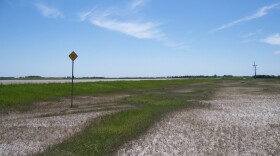Summer is upon us! It seems that every year, questions come up on how to identify poison ivy, and what to do if a dog has been sprayed by a skunk. A little reminder of identification of poison ivy and treatment of skunk spray might be helpful.
Poison ivy has been documented in all but a handful of counties in North Dakota. Although the form of poison ivy may vary, in North Dakota it is a sparsely branched upright shrub that grows to one or two feet tall, and because it is rhizomatous it often grows in patches. The casual observer may not notice that it is a shrub, but a closer look will reveal the woody growth.
That old saying “leaves in three, let it be” is good advice. The leaves, alternately arranged on the stem grow near the tip of a branch. Three shiny leaflets, about as long as wide, are produced from distinctive leaf stalks. The leaf margins may be entire or perhaps coarsely toothed. The leaves may be two inches long early in the growing season but become larger as the season progresses. And the leaves often droop and may have a distinctively reddish or bronzy tinge.
The flowers (June) are rather inconspicuous, but the fruits are pale-yellow with perhaps a tint of green, about a quarter of an inch in diameter, and often quite noticeable.
Simply touching the leaves may result in blistering. The active agent (urushiol) is an oil. So, flushing the exposed area with water does not work. Tecnu is a product that is effective on skin, clothing, and other items contaminated with poison ivy oils.
The result of a dog getting into a skirmish with a skunk is self-evident. But then what?
Treatment with tomato juice is often suggested, but that does not work. There may be some over the counter treatments that work, but a chemist has developed an effective treatment using household ingredients. It involves liberally bathing the dog in a mixture of hydrogen peroxide, baking soda, and liquid soap or dish detergent.





